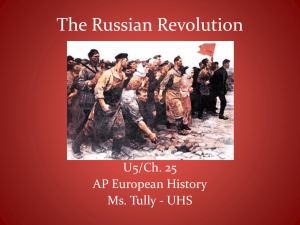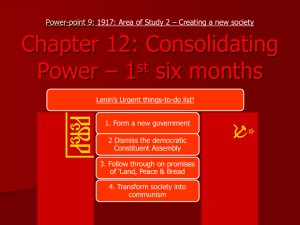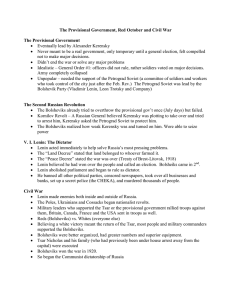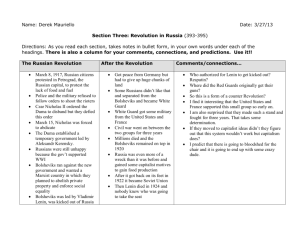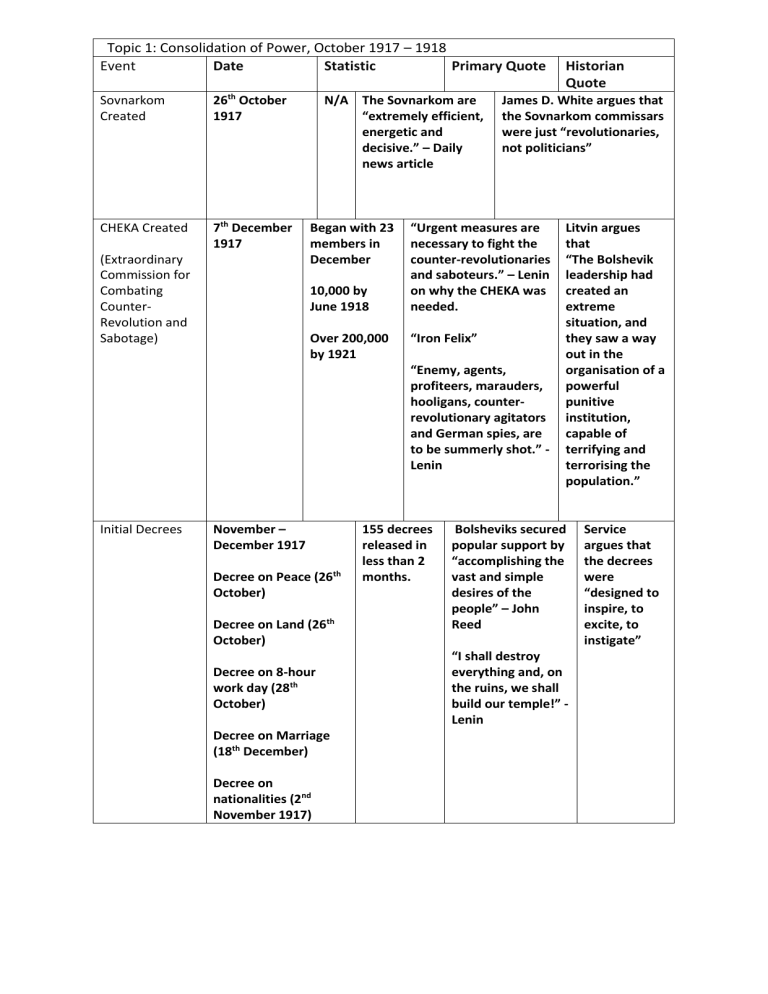
Topic 1: Consolidation of Power, October 1917 – 1918 Event Date Statistic Primary Quote Sovnarkom Created 26th October 1917 CHEKA Created 7th December 1917 (Extraordinary Commission for Combating CounterRevolution and Sabotage) N/A The Sovnarkom are “extremely efficient, energetic and decisive.” – Daily news article Began with 23 members in December 10,000 by June 1918 Over 200,000 by 1921 James D. White argues that the Sovnarkom commissars were just “revolutionaries, not politicians” “Urgent measures are necessary to fight the counter-revolutionaries and saboteurs.” – Lenin on why the CHEKA was needed. “Iron Felix” “Enemy, agents, profiteers, marauders, hooligans, counterrevolutionary agitators and German spies, are to be summerly shot.” Lenin Initial Decrees November – December 1917 Decree on Peace (26th October) Decree on Land (26th October) Decree on 8-hour work day (28th October) Decree on Marriage (18th December) Decree on nationalities (2nd November 1917) 155 decrees released in less than 2 months. Historian Quote Litvin argues that “The Bolshevik leadership had created an extreme situation, and they saw a way out in the organisation of a powerful punitive institution, capable of terrifying and terrorising the population.” Bolsheviks secured popular support by “accomplishing the vast and simple desires of the people” – John Reed “I shall destroy everything and, on the ruins, we shall build our temple!” Lenin Service argues that the decrees were “designed to inspire, to excite, to instigate” Constituent Assembly 12th November 1917 (Voting starts) th 5 January 1918 (Constituent Assembly opens and is forcefully closed by the Red Guard later) Treaty of BrestLitovsk 3rd March 1918 State Capitalism April 1918 Bolsheviks gained 28% of votes Socialist Revolutionaries gain 48% of votes. Lenin uses 5000 loyal soldiers to close down the assembly. “Only scoundrels and imbeciles can think that the proletariat must win a majority of votes in elections” – Lenin “It passed almost unnoticed.” – Victor Serge “The town cannot be equal to the country” and that the town “leads the country” - Lenin Russia loses 34% of “I spit on Russia. European This is merely a Population phase through which we must Over 1 million pass on the way square kilometres to world of land. revolution” – Lenin Loses 40% of its food production “To secure a (Loss of truce at present breadbasket aka means to Ukraine) conquer the whole world.” – Loses 90% of their Lenin coal production N/A ‘Bourgeoise Specialists’ Lenin states that state capitalism was “several steps towards socialism” Stephan Smith argues that “by closing the Constituent Assembly, the Bolsheviks signalled that they were ready to wage war in defence of their regime” Pipe argues that the “machine gun became for them the principal instrument of political persuasion” Crampton argues that the Treaty of Brest-Litovsk was “to trade space for time, the time which they needed to consolidate their revolutionary rule.” Rex Wade argues that the workers “pushed the Bolshevik leaders faster than the latter wished to go” Topic 2: Civil War (1917 - 1922) Internal Threats • Green Armies • White armies • Czech Army 1918-1920 (Defeated by 1920) 40,000 armed Czech soldiers External Threats 1918-1920 (Withdrew by 1920) Britain spent 70 million pounds to support White forces. • • • Britain Japan America Soviet-Polish War The Red Terror 7th December 1918 – 1921 Murder of the Romanovs (17th July 1918) 30th August 1918 (Attempted assassination of Lenin by Fanya Kaplin) Decree on Red Terror (5th September 1918) Feb 1919 – 18th March 1921 Japan sent 70,000 soldiers to claim Russian land. N/A 84 Concentration camps established 87,000 arrests made. Confronted 245 revolts and exposed 142 counterrevolutionary groups. 140,000 suspected counterrevolutionaries executed without trial and killed another 140,000 while suppressing uprisings. (Okhrana only killed 14,000 in 50 years) Lenin would N/A claim that “the green armies are far more dangerous” than the White forces. “Strangle N/A Bolshevism at birth” - Churchill “The bayonet is an essential necessity for introducing communism” – Karl Radek “We must execute not only the guilty. Execution of the innocent will impress the masses even more” Commissar of Justice, Krylenko “The Cheka is not an investigating commission… It Is a fighting organ on the internal front of the Civil war. It does not judge, it strikes.” – Martin Latis. “Cheka must defend the revolution…. Even if its sword falls occasionally on the innocent” – Dzerzhinsky Taylor argues that the “Soviet leaders abandoned the cause of international revolution” after the defeat in Poland. Fitzpatrick argues that the Cheka evolved from a “security force” to an “organ of terror” overtime. Figes argues that the Bolsheviks were “forced to turn increasingly to terror” as they could no longer control the masses by any other means Service argues that the Bolsheviks believed “overkilling was better than running the risk of being overthrown” Figes argues that terror was an integral “element of the Bolsheviks regime from the beginning” Topic 3: Why did the Red Army win? Why did the White Army lose? Red Army White Army Common Purpose: Bolsheviks used propaganda Lack of Unity: There was no one purpose and Russian patriotism to unite the Red Army among the White armies. The white generals (You either fight for Russia or be classed a who were willing to cooperate couldn’t due to traitor). Thus, the soldiers were willing to fight being separated by distance, and unable to for Russia against the Tsarist regime that had coordinate attacks together or unite their destroyed their country. forces to become a more powerful force. Concentration of Defence: Bolsheviks controlled only the main cities, while the whites dominated most of Russian lands (They were poorly organised and spread out though) meaning the Bolsheviks were able to have a stronger centralised defence. Bolsheviks also controlled the industrialised land of Russia meaning they were able to produce equipment, ammunitions, supplies and railway stations. Trotsky’s Red Army: Formed in January 1918 by the Sovnarkom and consisted of workers and peasants. They were led by the Minister of War Trotsky; whose ruthlessness created a disciplined army large army. White Terror: Despite the fact that the Bolsheviks used the CHEKA as a tool of terror they would paint the Whites are being monsters and traitors which was further exacerbated by Trotsky genius use of propaganda which would portray them as traitors due to their financial support coming mainly from the Allies (Whites lacked propaganda that would support them). White terror would consist of burying socialists alive, nailing people to trees, destroying bridges, gouging eyes, cutting off tongues, tearing off limbs, and burning off skin. CHEKA and Red Terror: (Refer to next table) Statistics 75,000 tsarist officers conscripted to serve as ‘military specialists’ 4 million Red Army conscripts desert during the Civil War Only 360,000 men volunteered to serve in the Red Army by May 1918 Statistics Denikin’s army killed 150,000 innocent Jews Kolchak’s army killed 25,000 people in one city alone Total of 260,00 people died as a result of white terror. 3 million soldiers by 1919 Reds outnumber whites 2:1 Primary Quotes “We are fighting to settle the question of whether Russia will belong to the people who lived by their labour… or whether they belong to the bourgeoisie.” – Trotsky “Cowards, bastards and traitors will not escape the bullet!” – Trotsky “Everything for the front!” – Trotsky (Appointed Commissar of war, March 1918) Primary Quotes “I am not fighting for any particular form of government, I am only fighting for Russia!” – General Denikin Historian Interpretation CPSU argues that the Red Army “fought for the right policy” and that the “people loved them” Fitzpatrick argues that the Reds were viewed as the “lesser evils” granting them “active support and passive acceptance” from society. Pipes argues that the Reds were victorious due to their “superiority in manpower and war material” and not due to their popularity. Figes argues that the Reds were “defending the revolution” and that the whites were still "associated with the old regime” Topic 5: War Communism (1918-1921) Issue: Cause Grain Requestioning Russia loses control of (May 1918) Ukraine in Treaty of Brest-Litovsk (March 1918), grain imports decrease by 40% Extreme bread shortages in cities, e.g. Petrograd citizens can only purchase 50g bread per day Peasant Resistance Peasants resist grain requisitioning by: Resorting to subsistence farming Hiding grain Economic breakdown in cities Murdering 15,000 requisitioning agents between 1918-1920 Factories going bankrupt and increasing unemployment Popular demands for workers’ control of the factories Historian Interpretation Figes states that Bolshevik victory was more as a result of “white weakness than Red strength” Pipes argues that the whites failed to recognise the “peasant revolution” which was the reason for their “ultimate defeat” Ryan argues that the whites “targeted Jews as the scapegoats for all the perceived wrongs of the revolutionary system” Figes argues that the Whites were the “avengers of those who had suffered at the hands of the revolution” Effect Decree on Food Supply (May 1918) All ‘surplus’ grain grown by peasants to be requisitioned by force Commissariat of supply sends requisitioning parties to countryside From August 1918, Food Battalions of 75 armed men created to seize grain from peasants by force. Cheka patrols used to surround and terrorise villages during requisitioning. Decree on Nationalisation of Industry (June 1918): All factories taken over by Soviet Government Significance Inadequate supplies of food secured to feed cities and Red Army Growing resentment of regime by peasantry. Cycles of increasing violence between Bolsheviks and peasants, which ultimately lead to 50 large peasant rebellions in 1921. Key factories kept running to supply Red Army Growing resentment of regime by workers due to insufficient rations, e.g. Petrograd Failure of rationing system Famine (1921) Decree on Abolition Industrial disruptions of Private Trade threaten war effort (November 1918): money abolished, Bread shortages workers paid in rations. Workers turns to Black Key factories are market, which militarised with armed supplies 2/3rd of guards monitoring nutrition by 1921 workers and harsh discipline introduced. Workers engage in ‘bag trade’, with 30% absent from work on any given day bartering for food. Requestioning agents Overzealous grain have increasing requisitioning agents difficulty meeting food confiscate seed, grain collection targets to and grain reserves. feed cities. workers received less than 1000 calories per day in 1921 Growing resentment of regime by workers 50% of workforce flees the cities 191821 Industrial production decreased by 75% 1917-21 Food production in Central Russia decrease by 85% 1917-1921 1921 famine kills 5 million. Statistics: Out of 10 million deaths during the Civil War, 9.5 million were attributed to famine and disease caused by War Communism. American relief organisations saved over 14 million peasants. 100 kulaks hanged (suspected of hoarding grain) Primary Source: “He who does not work shall not eat” – Lenin “Ruthless war on kulaks. Death to Kulaks” – Lenin “Famine bread” (made of clay/grass) “In our village everyone eats human flesh but they hide it” – A witness “We were forced to resort to War Communism by war and ruin” Historian Quote: Pipes argues that “War Communism had reduced it to levels that threatened Russia’s very survival” Smith argues that the Bolsheviks had “no choice but to take from the hungry and to give to the hungrier” Pipes argues that War communism was not a “response to the Civil War” but an attempt to “construct a communist society” CPSU argues that War communism brought “victory in the Civil War” and would’ve been “impossible without War Communism” Topic 6: Crisis and Compromise (1921 to 1927 Peasant Peasants anger Red Army and Cheka Peasant Rebellions over grain rebellions ordered to crush requisitioning neutralise by rebellions. Ruthless late 1921 4.4 Million tactics used, peasant’s Bolsheviks conscripts including summary control demobilised restored executions of from Red Army and sent home, suspected rebels and begin rebelling burnings of entire against regime after they rebel villages. discover poor conditions Grain requistioning 50 major peasant abandoned and new uprisings, e.g. Tambov Revolt economic policy involved 50,000 introduced. rebels Kronstadt 1st March 1921 50,000 Red army “Soviets without Uprisings (Manifesto soldiers used to Bolsheviks” – released defeat sailors, Kronstadt demanding end 10,000 of which Sailors to War dies. Communism and “Reddest of the democratic 6,500 sailors Red” and “pride reforms) were imprisoned, of the glory of 5000 killed and the revolution” 16-17th March 12,000 fled. – Trotsky 1921 (Red Army crushes Lenin called the rebellion) outcome “an unfortunate by necessary step” Fitzpatrick argues that the Kronstadt Uprising was a “symbolic parting of the ways between the working class and the Bolshevik party” Ryan argues that the uprising was the point that the “Bolsheviks broke their last true links with the working class and with the ideals of October.” Lynch argues that it wasn’t the demands themselves that scared the Bolsheviks; “it was the people who drafted them” One Party Unity (Workers Opposition) New Economic Policy (1921-27) 19211927 1921 March Cause: Effect: Significance: Alexandra Kollontai forms Workers’ Opposition faction of Bolsheviks to criticise War Communism Lenin makes speech ‘On Unity’ which bans factions and orders purges of critics Criticism of Lenin’s leadership neutralised Lenin’s control over party restored. Grain production increased by 100% (1921 – 1924) “New exploitation of the Proletariat” – Workers who didn’t benefit from the NEP Lynch argues that the NEP was another attempt to seize food from the peasants to “meet Russia’s urgent need for food” Grain requisitioning replaced by 10% tax in kind (1921 – 1924) “We must go one step backwards to make 2 steps forward” – Lenin Figes argues that the Nep was a “desperate bid to stem the tide of popular revolution” Electricity increased by 300% (1921 – 1924) Coal production increased by almost 11.5 million tonnes by 1925 “Strategic retreat” – Lenin “What is needed now is an economic breathing spell” – Lenin “The first thing to do is to restore, consolidate, and improve peasant farming” – Lenin “The first sign of the degeneration of the Bolsheviks” Figes argues that the Bolsheviks had “surrendered to the peasantry” Malone argues that the “Nep was nothing short of treason” for traditional communists. Malone argues that “Bolshevik economic planning can be considered merely a fragmented response to a series of desperate situations.” Ryan argues that the NEP was a “betrayal of the proletariat”
